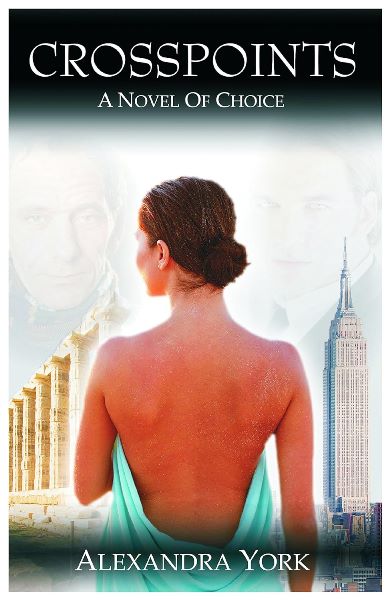Translating deep thinking into common sense
A Romantic Novel about Revealing Choices in Love and Art

By Walter Donway
October 11, 2023
SUBSCRIBE TO SAVVY STREET (It's Free)
Crosspointsby Alexandra York is indeed an excellent novel, but the parallels with The Fountainhead are far more specific.
I read Ayn Rand’s The Fountainhead in the fall of 1962, my freshman year at Brown University (I had read Atlas Shrugged that summer). The Fountainhead celebrates the 80th anniversary of its publication this year and I never have found a novel I felt compelled to compare with it. I don’t mean I never found a novel as great; very different novels from other eras and different genres can achieve excellence in diverse ways.
 Crosspoints by Alexandra York (Promethena Press, New York, 2004) is indeed an excellent novel, but the parallels with The Fountainhead are far more specific. We encounter a startlingly original perspective on today’s New York City, its culture (in this case, the fine arts scene), and its contemporary mores and dominating ideas—all exposed without extenuation or euphemism. Like The Fountainhead, Crosspoints is a story of men and women whose talents, ambitions, and choices, in a city with almost unequaled scope for their expression, shape their lives and in turn shape the city. How individuals, seemingly neutralized by the sheer mass of humanity, in actuality will determine the future of the city and so their own destinies—happiness and achievement or nihilistic cynicism and destruction, that final sense that it was all worth it or not.
Crosspoints by Alexandra York (Promethena Press, New York, 2004) is indeed an excellent novel, but the parallels with The Fountainhead are far more specific. We encounter a startlingly original perspective on today’s New York City, its culture (in this case, the fine arts scene), and its contemporary mores and dominating ideas—all exposed without extenuation or euphemism. Like The Fountainhead, Crosspoints is a story of men and women whose talents, ambitions, and choices, in a city with almost unequaled scope for their expression, shape their lives and in turn shape the city. How individuals, seemingly neutralized by the sheer mass of humanity, in actuality will determine the future of the city and so their own destinies—happiness and achievement or nihilistic cynicism and destruction, that final sense that it was all worth it or not.
Settings and cultural commentary, the clash of ideas, do not make a novel in the Romantic tradition.
No, settings and cultural commentary, the clash of ideas, do not make a novel in the Romantic tradition, which is the standard by which I judge fiction. Crosspoints is part of that most demanding genre: a compellingly suspenseful, psychologically revelatory (to an almost unnerving extent), urgently contemporary novel that also is a novel of ideas. That it is by a woman who has been deeply immersed in what she writes about adds a vital credibility. Vital because York exposes everything including how we bare our souls to the world by our choices in sex and in the arts. What is exposed is both the appalling and the promising, the revolting and the beautiful, the evil and the good.
As I followed York’s love triangle from the Aegean Sea and Athens to New York City, I came to realize that at stake in encounters enchanting, painfully conflicted, sensually delightful, explosive, or at times bitterly lonely was nothing less than the individual soul. We do not often encounter that in fiction, not in a way that manifests the conflicts in action—at times thrilling, eloquently nuanced, maddeningly perverse, or endearing—and, at the same time, exposes the meaning of those conflicts right down to philosophical fundamentals.
Tara is a woman in love with heroes, not the two-gunned type but those we see in sculptures recovered from classical Greece—including by Tara, afire with the possibilities of her career in archeology. She loves the defining human heroism of matching our lives as lived with our highest ideals. Tara and the two men who crave her beauty, sensuality, and spirit—Dimitrios, her mentor, and Leon, the toast of the NYC avante-garde art scene and high society—are consumed in different ways by sexual desire and an obsession with art.
“Dimitrious walked to the edge and looked out over a dark sea. This sea, the same sea traveled by the ancient Greeks, the first people to understand that the ideal was an approachable goal and that the joy of living was striving toward that goal….Tara saw all of it this way, too. Her Greece, like his, was not crumbling architecture…. It was the fountainhead, the source of Western civilization itself.
“All this he shared with Tara, much of which he had taught her. Some of it he had taught her to love. Could he also not teach her whom to love?”
The reader of Crosspoints rides a narrative rollercoaster: successively intrigued, hopeful, and excited…rudely disabused and again hopeful, inspired…then near to pitying, horrified…then by degrees eager, moved to applause, and at last drawn up into the rarefied atmosphere of spiritual celebration. None of it is easy, none obvious, none assured. It is Tara’s journey, too, not riding the rollercoaster but fighting to determine her own direction.
Crosspoints is punctuated by fully realized scenes that linger in your memory. There are the emotion-charged romantic discoveries of historic loci of the human spirit in the ancient world. There is the quintessential New York City of Tara’s Greek American immigrant family with its tantalizing blend of American aspiration, Old World tastes and sounds and celebrations, and moral certainties today so neglected that they evoke nostalgia. There is the surreal New York City of artists, galleries, a now-banal ethos of “shocking new art,” critics, modern-day patrons—and, almost an invisible stream flowing beneath it, the new talent, the tentative new visions, the young who must in this milieu make their choices and ultimately their souls.
These worlds are alive with a cast of characters we meet with Tara, Leon, and Dimitrios. Crosspoints does not let us forget that these worlds have no life of their own apart from the ideas, the philosophical premises implicit or explicit, of those whose choices and actions create and perpetuate them. The worlds themselves change only slowly, but the characters cannot stem their own headlong trajectory toward the moments when they face the reality of what they have chosen.
If the theme of Crosspoints is that our choices in the realms of art and sexuality are never just “outer” or just “inner”—always and inevitably both, whether or not we consciously intend it—then Alexandra York’s literary style is the fullest realization of that (for better or worse) inescapable integrity of mind and body, spirit and matter.
“The city lights cut through an open sliver of drapery, causing the blue sheets to accentuate the outline of Tara’s face and give an opalescent quality to the texture of her skin. A pale shade of pink lay on her cheeks. [Leon]…studied the fragile detail of her closed eyelashes. That stark blackness of her hair in contrast with the pale delicacy of her features made him wish he was a painter. The inner purity of this woman, the freshness, the life.
“So his youthful ideal of a woman was possible. It was his. But what was he to do now? How could he keep Tara when he had lied and cheated every inch of the way so far to get her?”
Whether we are seeing the nude beauty of Tara, a sculpture chistled from coral on the floor of the Aegean sea, or a painting on a museum wall (or in a lonely atelier), York’s language gives us the colors, shapes, texture, smell, light and shadow, and experience of movement in a way that reflects and reveals meaning—personal to a character, revelatory of psychology, philosophical. Her style attains beauty whether she is showing us the perfection of a Greek athlete in motion, the grotesque couplings that mock sex and laugh at passion, a family utterly at one at a Greek Saint’s Day celebration, or a Palm Beach fundraising gala that faithfully expresses the grotesque parody of art and meaning that will be on display in the new museum wing that the funds will support.
Crosspoints is punctuated by fully realized scenes that linger in your memory.
“Well, my paintings lead you to a connect with something beyond consciousness: oblivion! And Braque had it right when he said: ‘If you ask me whether a certain, discernible form you may perceive within one of my paintings depicts anything extant in reality, I cannot give you an answer because metamorphic confusion is fundamental to the theme of all my work.’”
Even as Tara, Dimitrios, and Leon, the radioactive nucleus of the narrative, arrive at scenes that let us feel that their battles have been fought to a decision, other arrays of other characters, who have deepened the conflicts and psychological complexity of Crosspoints in the orbit of the nucleus, satisfy our need to at least guess their future.
The questions that remain when you close Crosspoints are likely to be about the future that awaits those who come after us, awaits New York City itself, the ideals of art and beauty and our image of man, and the philosophies that have competed throughout history and today are battling to shape very different American futures.
First published in The Atlas Society on September 6, 2023, under the title “Crosspoints Lays Bare the Soul We Reveal in Sexual Choices and Creation of Art.”








